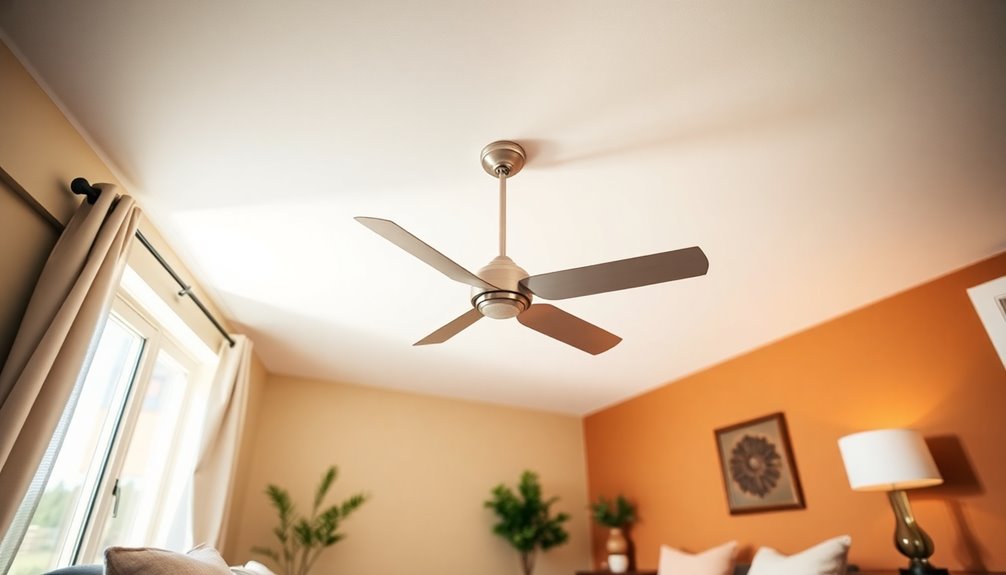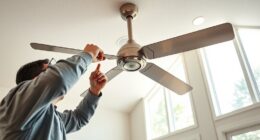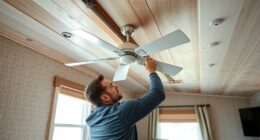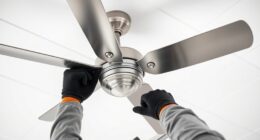If your ceiling fan's making a clicking noise, it usually means something isn't right. Loose blades, misaligned components, or debris could be causing the issue. Start by checking the screws on the blades to guarantee they're tight. Also, inspect for any foreign objects that might be obstructing the fan's movement. If the blades wobble, they may need alignment or additional weight adjustments. Ignoring these sounds could lead to more significant problems later on. Keep an eye on it, and you'll find effective ways to resolve the issue for good. You might discover more helpful tips soon!
Key Takeaways
- Loose blades due to unsecured screws can cause vibrations and clicking noises during fan operation.
- Misaligned or bent blade arms may lead to contact with other components, resulting in clicking sounds.
- Foreign objects or debris caught in the fan blades can obstruct movement and create irregular clicking.
- Worn-out bearings in the motor may need lubrication or replacement to eliminate clicking sounds.
- Regular maintenance, including tightening screws and cleaning, helps prevent clicking and ensures smooth operation.
Common Causes of Clicking Noises

A clicking noise from your ceiling fan can be frustrating, and it often stems from a few common issues. One of the primary culprits is loose blades. If the screws holding the fan blades are loose, they can vibrate during operation, creating those annoying clicking noises. You'll want to check these screws regularly to prevent further problems.
Another potential cause could be misaligned or bent blade arms. If these parts come into contact with other components of the fan, they can also produce clicking sounds. Make sure the arms are straight and properly aligned to help reduce noise.
Foreign objects or debris obstructing the movement of the fan blades can lead to irregular clicking noises as well. It's important to keep the area around your fan clean and clear of any obstruction.
Lastly, worn-out bearings in the fan motor may generate clicking sounds, signaling that it's time to lubricate or replace them. Regular maintenance, including checking for loose blades and other damages, can help you easily diagnose and fix these issues before they escalate. Additionally, addressing a clicking noise promptly is crucial, as it may indicate potential mechanical failure that could lead to more serious safety hazards.
Inspecting Your Ceiling Fan

To start inspecting your ceiling fan, check the tightness of the blades and their holders.
Loose screws can create clicking noises, so make sure everything is secure.
Next, look for any obstructions that might be caught in the blades, as these can also lead to unwanted sounds during operation.
Check Blade Tightness
Verifying your ceiling fan runs smoothly often starts with checking blade tightness. Loose screws can lead to annoying clicking noises while the fan is in operation.
To tackle this, grab a ladder or step stool to safely access each fan blade for a thorough examination. It's essential to inspect the screws on every blade, confirming they're securely fastened. If you find any loose screws, tighten them gently, but be careful not to overtighten. Doing so can cause bending or damage to the blades, potentially worsening the noise issue.
Regular maintenance, including checking blade tightness, not only helps eliminate clicking sounds but can also prolong your ceiling fan's lifespan.
If the clicking persists even after tightening the screws, it might be time to look for other issues. Blade warping or misalignment could also contribute to the noise you're hearing.
Inspect for Obstructions
After checking the blade tightness, the next step is to inspect for obstructions around your ceiling fan. Start by looking closely at the fan blades for any foreign objects, like dust, debris, or hanging wires that could be causing those annoying clicking noises.
Make certain there's nothing in the area above the fan, such as loose insulation materials that might come into contact with the blades during operation.
Also, check if the fan blades are too close to the ceiling or nearby fixtures, as this proximity can lead to scraping or clicking sounds.
Don't forget to examine the light fixture attached to the fan; loose components there might rattle or click when the fan is in motion.
To prevent future issues, regularly clean the fan and its surroundings. Dirt buildup can cause imbalances, increasing the chances of obstructions that lead to noise.
Tightening Loose Components

Regularly tightening loose components on your ceiling fan is essential for maintaining its performance and minimizing annoying clicking noises. Loose screws on the fan blades or blade holders can be the source of the noise you're hearing. To prevent this, you should inspect and tighten these screws regularly.
Using a screwdriver, go through each screw that holds the blades and light fixtures. Verify they're secure, but be careful not to overtighten, as this can bend the components.
Incorporating regular maintenance checks into your routine can considerably prolong the lifespan of your ceiling fan. By systematically tightening the screws, starting from the blade holders to the light fixture, you can effectively eliminate clicking noises and improve overall fan performance.
Additionally, make sure the fan blades are aligned correctly and securely attached. This helps prevent imbalances during rotation that can lead to loose or damaged parts.
With a little effort in tightening these components, you'll not only reduce noise but also enjoy the smooth operation of your ceiling fan for years to come.
Identifying Wobbly Fan Blades

If you notice a clicking noise coming from your ceiling fan, one common culprit might be wobbly fan blades. Wobbling occurs due to uneven weight distribution, which can lead to imbalance while the fan operates.
Start by inspecting the blades for any visible damage, such as warping or cracks; damaged blades can worsen wobbling and noise.
Next, verify that all screws and fasteners securing the blades are tightly fastened. If you find any loose screws, tighten them to help eliminate the wobbling and prevent that annoying clicking noise.
It's also a good idea to regularly check the alignment of your fan blades. They should be level and equidistant from the ceiling to maintain balance.
If you still experience issues after these checks, consider using a fan balancing kit. This kit can help correct minor wobbling by adding weights to the blades, stabilizing the fan, and markedly reducing noise.
Checking the Canopy Cover

One common source of clicking noise in ceiling fans is a loose canopy cover. This cover can rub against the ceiling or downrod during operation, leading to that annoying sound.
To tackle this issue, follow these simple steps:
- Inspect the Canopy: Check for any visible signs of looseness or movement. If you notice any, it's likely contributing to the clicking noise.
- Tighten the Screws: Securely tighten the screws or fasteners that hold the canopy to the ceiling. This can notably reduce or eliminate the noise.
- Regular Maintenance: Make it a habit to regularly check the canopy cover. Consistent maintenance helps prevent scraping or clicking noises from developing over time.
- Assess for Damage: If the canopy appears warped or damaged, it may need adjustment or replacement to guarantee a snug fit and smooth operation.
Adjusting Light Fixtures

A loose light fixture can be a significant source of clicking noise in your ceiling fan. To address this issue, you need to inspect the screws and fasteners on the light kit. A simple tightening can often eliminate that annoying clicking sound. Start by removing the light globe or shade to gain better access to the screws. Make certain all components are securely fastened and free of damage.
If you're still experiencing problems, check the compatibility of your light fixtures. Incompatible fixtures or incorrect wattage bulbs can cause vibration, contributing to noise. Verify your light fixtures meet the specifications of your ceiling fan.
Lastly, keep your fixtures clean. Accumulated dust and dirt can lead to noise issues, so regular maintenance is key. Here's a quick checklist to help you:
| Task | Frequency | Notes |
|---|---|---|
| Inspect screws | Monthly | Look for looseness |
| Clean light fixtures | Every few months | Use a soft cloth |
| Check bulb wattage | When changing bulbs | Match fan specifications |
| Tighten fasteners | As needed | Don't overtighten |
| Examine for damage | Annually | Replace if necessary |
Follow these steps, and you can minimize that clicking noise effectively!
Importance of Regular Maintenance

Regular maintenance is essential for keeping your ceiling fan operating smoothly and quietly. By regularly checking your fan, you can identify and fix issues like loose blades or screws that contribute to annoying clicking noises.
Here are four key benefits of maintaining your ceiling fan:
- Prevents Escalation: Scheduled maintenance helps catch minor problems before they turn into costly repairs.
- Enhances Performance: Cleaning blades and components regularly reduces dust buildup, decreasing imbalance and noise.
- Decreases Mechanical Noises: Tightening screws and fasteners during maintenance can considerably lower the chances of mechanical clicking noises.
- Tracks Performance: Keeping a record of inspections helps monitor your fan's performance over time, making it easier to address any unusual noises promptly.
When to Seek Professional Help

If you hear persistent clicking noises despite tightening screws, it might be time to call in a professional.
They can help identify any electrical issues or mechanical problems that could pose safety risks.
Don't hesitate to seek expert assistance, especially if you're unsure about the source of the noise or how to fix it.
Identifying Electrical Issues
How can you tell when a clicking noise from your ceiling fan signals an electrical issue? If you notice this unsettling sound, it's vital to act quickly.
Start by turning off the power to your fan to prevent hazards like short circuits or fire. Next, watch for specific signs that indicate electrical issues:
- Overheating: If the fan feels hot to the touch, this could signal a problem.
- Burning Odors: Any strange smells might mean serious electrical issues need immediate attention.
- Incompatible Controls: If the clicking noise coincides with light dimmers or speed control switches, you may have compatibility issues.
- Persistent Noises: If clicks continue after you've tightened connections and checked installation, it's time for a professional inspection.
Ignoring these signs can lead to more severe problems down the line.
Regular maintenance and inspections by qualified electricians can identify and resolve electrical issues early, ensuring the safety and longevity of your ceiling fan.
Don't underestimate the importance of addressing these ceiling fan noises swiftly!
Diagnosing Mechanical Problems
Addressing electrical issues is just the beginning when it comes to a ceiling fan that's making clicking noises. If you've tightened all screws and checked for loose components but the noise persists, you might be dealing with mechanical issues that require a professional assessment.
Pay attention to the nature of the clicking sound; irregular clicking at different speeds often suggests that the fan blades are unbalanced or misaligned.
If your fan is wobbling or shaking excessively during operation, this could be a sign of a more serious mechanical problem that necessitates expert intervention.
Additionally, a clicking sound accompanied by grinding or scraping may indicate motor issues that should be evaluated by a qualified technician to prevent further damage.
Regular inspections by a professional can help catch these mechanical issues early on, potentially saving you from costly repairs or replacements later.
Don't hesitate to seek help if your ceiling fan remains noisy after your initial checks; addressing these problems promptly can guarantee your fan operates smoothly and efficiently.
Ensuring Safe Operation
Guaranteeing the safe operation of your ceiling fan is essential, especially when persistent clicking noises arise. If you've tightened all visible screws and checked for loose components but the noise continues, it's time to seek professional assistance. Ignoring these issues can lead to safety risks, particularly if electrical issues are involved.
Here are some key indicators that you should consult a professional:
- Persistent Clicking Noises: If clicking noises remain after basic checks, don't delay in getting help.
- Electrical Sounds: Crackling or sizzling noises indicate potential electrical issues that require immediate attention.
- Incorrect Installation: If the fan was installed incorrectly or shows signs of mechanical failure, a professional can guarantee it's set up safely.
- Complex Repairs: Avoid attempting to fix complex mechanical or electrical issues without the right expertise, as this can lead to even greater safety risks.
Regular maintenance checks can help identify issues early, minimizing the need for professional intervention.
However, when in doubt, it's best to prioritize safety and call in a qualified electrician to resolve any problems you're facing.
Tips for Quiet Fan Operation

To keep your ceiling fan running quietly, it's essential to stay on top of maintenance and adjustments. Start by regularly tightening the screws and bolts on your fan. Loose components are often the culprits behind annoying clicking noises.
Next, make it a habit to clean the fan blades; dust and debris can create imbalances that lead to noise during operation.
Another important step is to verify you balance the fan correctly. Check that all blades are aligned and free from warping, as this can greatly reduce clicking sounds while enhancing performance.
If you're looking to upgrade your fan, consider choosing a ceiling fan with a higher number of blades. More blades can operate more quietly because they don't need to spin as fast to achieve adequate airflow.
Finally, keep an ear out for any unusual sounds after performing these maintenance tasks. If the clicking persists, it may be time to consult a professional.
Frequently Asked Questions
How Do I Stop My Ceiling Fan From Clicking?
To stop your ceiling fan from clicking, start by inspecting the screws on the fan blades and blade holders.
Tighten any loose components you find.
Next, check for foreign objects that might be obstructing the blades.
Confirm the blade arms are aligned and undamaged.
Regularly clean the blades and housing to reduce dust accumulation.
If the clicking continues, it might be best to consult a professional for further assessment.
Why Does My Ceiling Make a Clicking Sound?
Did you know that over 50% of ceiling fans experience some noise during operation?
If your ceiling's making a clicking sound, it could be due to several factors. Loose screws, worn blades, or foreign objects might be causing the noise.
It's important to inspect and tighten any loose components. Regular maintenance can help you avoid these noises and guarantee your fan operates smoothly, creating a more pleasant environment in your space.
Why Is My Fan Motor Making a Clicking Noise?
Your fan motor might be making a clicking noise due to several reasons.
It could be caused by loose or damaged components within the motor, like bearings or mounts. Misalignment of the motor or blades might also lead to contact that creates the sound.
Additionally, debris trapped in the motor housing can interfere with rotation.
If the noise persists after checking these issues, you should consider getting a professional to evaluate it.
Why Is My Ceiling Fan Making a Knocking Noise?
Your ceiling fan's knocking noise might feel like a drumbeat echoing in your room.
It often happens due to loose blades or screws, causing an imbalance when you turn it on. Misaligned blade holders could lead to the blades hitting the motor housing, creating that annoying sound.
If it's improperly mounted, it might shift and knock against the ceiling.
Regularly tightening screws and checking for wear can help keep your fan quiet.
Conclusion
In the dance of your ceiling fan's blades, a clicking noise can be a pesky partner. By tightening loose components and ensuring everything's balanced, you can restore harmony to your home. Remember, just like a well-tuned orchestra, regular maintenance keeps your fan in tune and whisper-quiet. If you still hear that annoying click, don't hesitate to call in the pros. A little attention today can save you from a symphony of headaches tomorrow!









